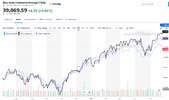bigdog
Retired many years ago
- Joined
- 19 July 2006
- Posts
- 8,242
- Reactions
- 5,700
Stock market today: Asian shares are mixed, with China stocks down, after Wall St retreat
Asian shares are trading mixed, as investor sentiment in Tokyo was boosted by news in the U.S. about soaring Nvidia earnings.
Wall Street retreats from its records as worries about high interest rates weigh
By STAN CHOEUpdated 7:05 AM GMT+10, May 23, 2024
NEW YORK (AP) — U.S. stock indexes retreated from their records Wednesday as concerns about high interest rates weighed on the market.
The S&P 500 fell 14.40 points, or 0.3%, to 5,307.01, a day after setting its latest all-time high. The Dow Jones Industrial Average sank 201.95, or 0.5%, to 39,671.04, and the Nasdaq composite slipped 31.08, or 0.2%, to 16,801.54 after after setting its latest record.
Indexes had been close to flat early in the day, but they slunk lower after the Federal Reserve released the minutes of its last policy meeting. Discouragingly for markets, the minutes showed Fed officials suggesting it “would likely take longer than previously thought” to get inflation fully under control following disappointingly high readings at the start of the year.
And even though Fed Chair Jerome Powell said after that meeting that the Federal Reserve is more likely to cut rates than to hike them, the minutes said “various participants” were willing to raise rates if inflation worsens. That cut at the rekindled hopes on Wall Street that the Fed will be able to cut its main interest rate at least once this year.
One of the market’s worst losses came from Target, which tumbled 8% after the retailer reported profit for the latest quarter that fell short of analysts’ expectations. It also gave forecasted ranges for upcoming profit where the midpoints fell below analysts’ estimates, as it said customers are holding back on purchases of non-essentials. Earlier this week, Target said it was cutting prices on thousands of everyday basics to entice customers struggling with still-high inflation.
Lululemon Athletica sank 7.2% after it said its chief product officer, Sun Choe, is leaving the company this month to “pursue another opportunity.” The company announced a new organizational structure where it won’t replace the role of chief product officer.
They helped to counter a 17.6% leap for Petco Health & Wellness, which reported results and revenue for the latest quarter that were better than analysts feared.
TJX, the off-price retailer, rose 3.5% after topping profit expectations. The company behind TJ Maxx and Marshalls also raised its forecast for earnings per share over the full year, saying its prices are helping to attract customers.
In the bond market, the yield on the 10-year Treasury rose to 4.42% from 4.41% late Tuesday. The two-year yield, which moves more closely with expectations for the Fed, rose a bit more. It climbed to 4.87% from 4.84%.
Helping to keep the move in yields in check was the fact that the harsh talk in the minutes from the Fed’s latest meeting was from May 1. That was before some reports showed softening in inflation and certain parts of the U.S economy, which may have changed the minds of some Fed officials.
In recent speeches since that May 1 meeting, some Fed officials have indeed called those recent reports encouraging. But they have also said they still need to see months more of improving data before they could cut the federal funds rate, which is sitting at its highest level in more than 20 years.
The Fed is trying to pull off a tightrope walk where it slows the economy just enough through high interest rates to get inflation under control but not so much that it causes a bad recession.
High rates have made everything from credit-card bills to auto-loan payments more expensive. Mortgage rates are also high, and a report on Wednesday showed sales of previously occupied homes were weaker last month than economists expected.
Central banks around the world seem eager to cut interest rates, but “they may not go far” given how well economies are doing and how high inflation still is, according to Athanasios Vamvakidis, a strategist at Bank of America. He said in a BofA Global Research report that he expects only shallow cuts to interest rates, which may also come later than financial markets seem to be forecasting.
In stock markets abroad, indexes were modestly lower across much of Europe and Asia.
London’s FTSE 100 sank 0.5% after the U.K. Office for National Statistics announced a stronger-than-expected inflation reading that hurt hopes for a rate cut in June. Tokyo’s Nikkei 225 fell 0.8% after Japan reported its trade deficit rose last month.
ASX 200 expected to fall
The Australian share market looks set for a tough session on Thursday following a poor night on Wall Street.According to the latest SPI futures, the ASX 200 is expected to open the day 74 points or 0.9% lower this morning.
In the United States, U.S. stock indexes retreated from their records Wednesday as concerns about high interest rates weighed on the market.
The S&P 500 fell 14.40 points, or 0.3%, to 5,307.01, a day after setting its latest all-time high. The Dow Jones Industrial Average sank 201.95, or 0.5%, to 39,671.04, and the Nasdaq composite slipped 31.08, or 0.2%, to 16,801.54 after after setting its latest record.

